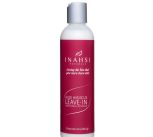Five Things You Should Know About Hot Combs - Page 3
Share the post
Share this link via
Or copy link
Can you recall the Easter Sunday’s of your childhood?
I surely can. Outside of creating eclectically painted eggs and putting on the freshest, most colorful inflated new dresses picked out by moms, a huge staple in our Easter morning ritual was an early date with the hot comb. Sitting on the stove cooking, you know the smell of a HOT hot comb from miles away. It smells like a cooked version of all the greases and hair aromas of those who use it. My mother put the hot comb on our bangs mostly, so that they would be bumped to perfection and incredibly silky smooth thanks to all that heat and a side of Blue Magic hair grease. She’d also clean up our napes, and we were always told, “hold your ear!” However much we cringed at the steam rising, or the hiss and pop the hot comb made when it touched our strands, we always left the house looking fresher than a crisp $2 bill.
Times have changed, and if you ask most women these days if they own a hot comb (not their mothers), they’ll likely say no. Flat irons sort of came through and took over. But for women who want to occasionally have straight styles but aren’t partial to irons and have natural hair, some are kicking it old school with hot combs. Sure, the stove top ones come with all the cautionary tales and warnings: If the comb gets too hot, you could burn up your hair, and even worse, burn up your skin. And who doesn’t hate nursing an ugly neck, face or ear burn with petroleum jelly and ice? But many of us know and have seen the benefits of the hot comb. If used every once in a while (not constantly), the end result can be shiny, full, lustrous head of hair. Or, broken off hair dry as sandpaper. If you’re looking to try your hand with a hot comb, here are five things you should know about the practice and the tool itself.
A Hot Comb Can Be TOO Hot
When a hot comb, the stove top version that is, sits and warms up on the stove, it needs to rest at a medium to medium low heat for less than a minute. To test the heat of the comb, many people recommend using a paper towel (not the really cheap thin ones) and holding it against the instrument. If the paper begins to burn, then it’s obvious that the comb is waaay too hot. And just as you wouldn’t want a scorching hot flat iron on your strands (for your hair and your hand’s benefit), you sure don’t want a searing hot comb passing through your head, close to your scalp. Not only can it burn your hair, but that can also lead to hair loss.
Madam C.J. Walker Didn’t Create the Hot Comb
Love MadameNoire? Get more! Join the MadameNoire Newsletter
We care about your data. See our privacy policy.
Big momma Walker is definitely the reason for a lot of the advancements in black hair care, but she did not create the hot comb like some believe. The hot comb was actually first used in France back in the late mid to late 1800s for those looking to sport wavy styles. They were also obviously embraced for their straightening effects, as many wanted to wear the bone straight styles they believed Egyptians had previously rocked. Walker did however, later on improve the hot comb by widening its teeth for us thicker haired sisters, and would go on to receive most of the credit for the tool. So the moral of this story is, if you snooze you lose. Oh yeah, and the wider the combs teeth, the better.
Relaxers and Hot Combs Don’t Get Along
I’m sure you know many women, especially older women, who in their lifetime put a hot comb on their permed hair. But many sources say that’s a no go. Even if you’re just looking to clean up a little new growth. The area between permed hair (which can be delicate because of chemical exposure) and new growth, which is a lot tougher, is scientifically referred to as the demarcation line. That area is extremely feeble, and if the massive heat from a hot comb touches permed hair, or worse, goes through your entire head, you run the risk of your hair coming apart at that line.
A Clean Hot Comb Works Better Than a Greasy One
With a regular flat iron, what really needs to be done to clean it? A good wipe down at the most so that you don’t have last weeks grease on this weeks freshly washed ‘do. But a hot comb needs some thorough cleansing to ensure that it works properly. Built up gunk and grease obviously hides better in a hot comb than it would in other straightening instruments and extra mess can burn your hair quicker. Get yourself a bowl of some sort and fill it with water (don’t immerse the entire comb), and then throw in baking soda. The chemical compound can do wonders if left to work on the comb for over an hour, rinsed and left to dry.
It’s Electric vs. Pretty Hot and Taming
If you’re looking to revert back to the hot comb but feeling apprehensive about what the effects might be, the stove top hot comb is not your only option. The electric hot comb has been lauded by many women with natural hair and gives you a little less to worry about. The biggest benefit of it being the control you get over the amount of heat you have to expose your hair to. The comb will still be able to fully envelop your hair but without the sweltering heat that can burn your ear from afar. Great electric brands include Andis, Conair and Gold ‘N Hot.
Electric Hot Combs:
Hot N Silky Pressing Comb by Silk Elements $24.99
Conair 2013HCS Hype Hair Hot Comb $14.49
Andis High Heat Press Comb $19.99
Stove Stop Straightening:
Gold N Hot Stove Pressing Comb $19.99
Golden Supreme Pressing Comb $16.49
Related Tags
African American hair black women hair hot comb Madam CJ Walker natural African American hair relaxer-

Vontélle Eyewear Founders Score History-Making Licensing Deal With Paramount
-

She Tried It: Inahsi Naturals Aloe Hibiscus Leave-In Conditioner & Detangler
-

She Tried It: Ivy Park Drip 2 and 2.2 Black Pack
-

My Husband And I Attempted To Have A Creative Date Night At Home -Without A Babysitter - Here's How It Went



